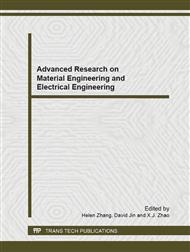[1]
Chong-Zhi Wang, Eryn McEntee, Sheila Wicks. Phytochemical and analytical studies of Panax notoginseng (Burk.)F.H. Chen [J]. Journal of Natural Medicine, 2006,60:97-106.
DOI: 10.1007/s11418-005-0027-x
Google Scholar
[2]
Fu-Cheng Luo, Sheng-Dong Wang, Kui Li. Panaxatriol saponins extracted fromPanax notoginseng induces thioredoxin-1and prevents 1-methyl-4-phenylpyridinium ion-induced neurotoxicity [J]. Journal of Ethnopharmacology, 2010,127:419-423.
DOI: 10.1016/j.jep.2009.10.023
Google Scholar
[3]
T.B. Ng. Pharmacological activity of sanchi ginseng (Panax notoginseng) [J]. Journal of Pharmacy and Pharmacology, 2006,58 :1007–1019.
DOI: 10.1211/jpp.58.8.0001
Google Scholar
[4]
Hong Bo Guo, Xiu Ming Cui, Na An. Sanchi ginseng (Panax notoginseng(Burkill) F. H. Chen) in China: distribution, cultivation and variations [J]. NOTES ON NEGLECTED AND UNDERUTILIZED CROPS. 2010,57:453-460.
DOI: 10.1007/s10722-010-9531-2
Google Scholar
[5]
H. Wang, J. Gao, J. Kou. Anti-inflammatory activities of triterpenoid saponins from Polygala japonica [J]. Phytomedicine.2008,15:321-326.
DOI: 10.1016/j.phymed.2007.09.014
Google Scholar
[6]
Ying-Ming Wang, Kwai-Sang Chin. A linear programming approximation to the eigenvector method in the analytic hierarchy process [J]. Information Sciences.2011,181(23):5240-5248.
DOI: 10.1016/j.ins.2011.07.009
Google Scholar
[7]
Hong-Qiang Liao, Yong Qiu, Xia Yang. A study of weight coeffient computing method based on AHP [J].Mechanical Engineers.2012,6:22-25.
Google Scholar
[8]
HUO Hong, LI Nan, WU Rong. Study on preparation of tea toothpaste for removing garlic smell [J]. Journal of Harbin University of Commerce (Natural Sciences Edition).2011,27(2):223-227.
Google Scholar
[9]
Zhao Peng, Li Wen-hong, Zhu Zhou-hai. Optimization for ultrasonic wave extraction of polysaccharide from Tussilago Farfara by response surface method [J]. FINE CHEMICALS. 2009 , 26 (6):546-549
Google Scholar
[10]
Quanhong, L.,Caili, F. Application of response surface methodology for extraction optimization of germinant pumpkin seeds protein[J]. Food Chemistry.2005, 92: 701–706.
DOI: 10.1016/j.foodchem.2004.08.042
Google Scholar
[11]
Pinho. C., Melo. A., Mansilha. C.,Ferreira, I. M. P. L. V. O. . Optimization of conditions for anthocyanin hydrolysis from red wine using response surface methodology (RSM) [J].Journal of Agricultural and Food Chemistry, 2011,59: 50–55.
DOI: 10.1021/jf103839j
Google Scholar


